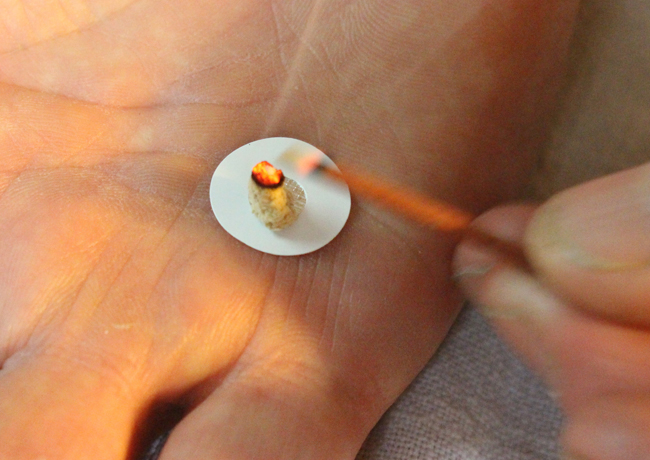
There are many holistic (healing) modalities we can use to regain and keep our health.
I can think of all the holistic modalities I have used before and now: acupuncture, moxibustion, craniosacral therapy, massage (shiatsu, anma, etc), physical therapy, qigong, t’ai chi, yoga, dance therapy, art and color therapy, lymphatic therapy, herbal therapy, aromatherapy, Bach flower therapy, hydrotherapy, nutritional counseling (macrobiotics), reiki, power crystal stone, hypnotherapy, meditation.
There might be more, but you get an idea of what I have done.
Some of them, I really enjoyed learning and receiving health by practicing daily, so I decided to go to school to learn and become a practitioner.
My not-so-secret of healthy practice is eating whole-grain, plant-based foods seasonally and according to my physical, mental, and emotional conditions. Also, I do yoga, meditation, and other healing modalities to tune myself up.
Today, I want to share about moxibustion (moxa), which may not be well known in the US yet, like acupuncture.
I love moxa because we can receive many benefits from it.
We can apply moxa to ourselves—it is not difficult to learn how to use and apply—and of course, you can help others. It was perfect for me since I do not like needles, so learning acupuncture was not my practice.

Different kinds and types of Moxa
I learned about moxa the first time when I was a child when my father was receiving anma massage and moxibustion at home from an anma practitioner, Mr. Yamauchi.
He was almost blind, but he rode his bicycle to our house after 10 pm, before my father went to bed.
I liked to receive anma massage from Mr. Yamauchi sometimes while he was waiting for my father to finish his bath, but I really was curious about moxibustion, since it was kind of a mysterious modality to me. It had a distinctive smell with smoke because you light it up with fire or incense. I loved the smell and the smoke somehow; I think it was Japanese aromatherapy, hahaha!
Massage and moxa combinations were excellent to relax the body and mind. When I received a little massage from Mr. Yamashita, even if I did not receive moxibustion, I was already relaxed from the smell and smoke.
When I had ovarian cancer in 1993, I used moxa, but I was too weak and had too much pain, so I could not apply my own.
I received it whenever my husband, Eric, was able to apply it for me.
I felt better, and it eased the pain.
I also have used moxa whenever I need to release pain (neck, back, shoulder, legs, etc.) or for overall health and energy.
I found a moxa stick holder about 10 years ago, so even if I am weak or have pain, I am able to apply it on my own (of course, it is nicer to receive from someone else, especially on my back).
Since last year, I have been using moxa again everyday to ease the liver pain for Primary Liver Non-Hodgkin of Diffuse Large B-Cell Lymphoma (DLBCL).
It also relaxes me, and I am able to rest or take a nap.

The moxibustion intro class
Moxa has been helping me so much, but not many people know about it,
so I decided to offer an introductory workshop class last Saturday.
The class reached capacity right away, and already a few other people have asked to come when I offer the next one—so I do plan to offer another moxibustion workshop.
If you want to attend, email me at sanaehealing@gmail.com.

Jay is applying a stick moxa with the holder over where he injured.

Moxa girls (from left, Kanako, Masako, Me and Masano) are using stick moxa with the stick holders!

Moxa on a ginger slice to help ease Masano’s back pain.

Brandon is applying moxa on a sliced ginger just above his navel for digestive systems and overall qi energy.

Vladka is applying moxa on the slice of ginger below her navel for stress, back pain etc.
Here is the topic outline and a little bit of info from the moxibustion intro class:
Workshop Topics
1) What is moxibustion?
2) How does moxibustion benefit our health?
3) How do you use moxa (moxa types)?
4) Which meridian points get benefits with moxibustion?
5) What are important things to do after moxibustion?
6) Are there any side effects from moxibustion?
7) Practice, practice, and practice!
What is moxibustion?
Moxibustion is started in China about 3000 years ago. Then, Japanese envoy to Sui Dynasty China and Japanese envoy to Tang Dynasty China brought to Japan. It is one of historical holistic home healing modalities, which has been written, in classic literature and Haiku.
Moxibustion is a form of heat therapy in which dried plant materials called “moxa” are burned on, or very near, the surface of the skin. The intention is to warm and invigorate the flow of qi in the body and dispel certain pathogenic influences. The moxa I use is usually made from the dried, leafy herbs of Chinese or Japanese “mugwort” (Artemisia argyi or Artemisia vulgaris).

Wild mugwort that I found in North Fork, California
How does moxibustion benefit our health?
Moxibustion helps with circulation, immunity, and lymph flow. It’s good for colds, the flu, and fever; pain in the eye, head, neck, shoulder, or back; sensitivity to cold; indigestion, constipation, and diarrhea; insomnia, swelling, palpitation, emotional instability, and stress; and liver, kidney, and other organ support. It gives energy and relaxes at the same time.
And bring smiles!

Eric’s Moxa smile!
If you are interested in purchasing premium-quality moxa, sticks, holders etc., please email sanaehealing@gmail.com.
With gratitude,
Sanae 💖
